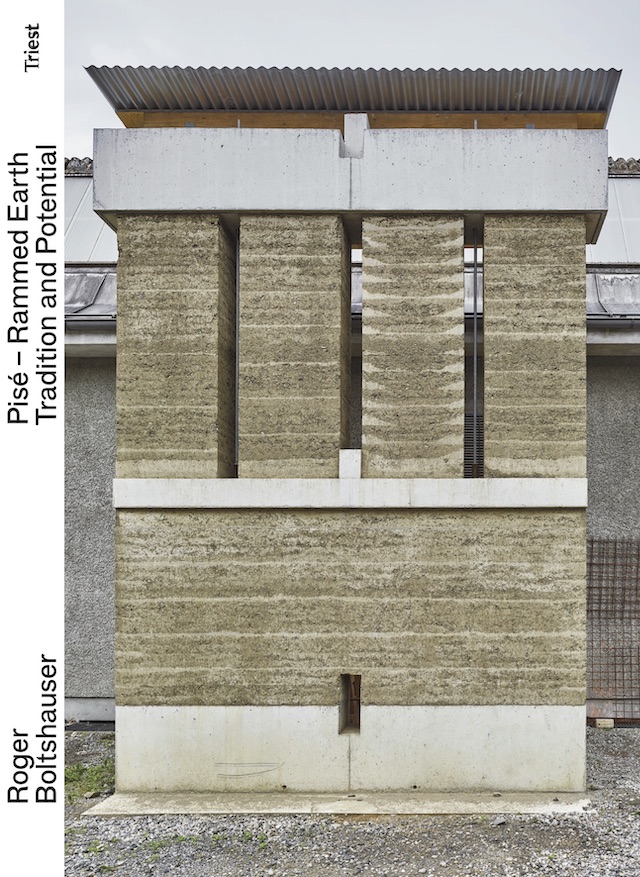Pisé – Rammed Earth
Pisé – Rammed Earth. Tradition and PotentialEdited by Roger Boltshauser with Cyril Veillon and Nadja MaillardTriest, 2019Paperback | 8-3/4 x 12 inches | 304 pages | 400 illustrations | English (also available in French and German editions) | ISBN: 9783038630289 | €60PUBLISHER'S DESCRIPTION:This book for the first time illustrates the history and significance of rammed earth construction in Central Europe, particularly in Switzerland, using historical examples to investigate the potential of that building technique for contemporary construction. As such, it represents a pioneering comprehensive documentation that will contribute to safeguarding existing architectural monuments, while also providing the foundation for further research.Based on that evidence, the editors investigate the material’s potential for modern day edifices, especially from the perspective of regional architecture claiming to establish identity and save resources.Due to the material’s advantages – rammed earth is strong, durable and non-combustible as well as providing quality indoor air conditions – it was already used in the 16th and 17th centuries. Today, disadvantages such as on site weather-dependency can be circumvented by using prefabricated elements. Possible load bearing problems solely due to pressure can be bypassed by pre-stressing the structure. By carrying out measures such as these, the building material – being ecologically sustainable and completely recyclable – will become an attractive alternative for contemporary construction methods.Roger Boltshauser, degree in architecture ETH BSA SIA. Established Boltshauser Architekten in Zurich in 1996. Besides running the practice, Boltshauser also taught at ETH Zurich and EPF Lausanne, HTW Chur and Chur Institute of Architecture CIA from 1996 to 2009. He was visiting professor at EPFL Lausanne and TU Munich. Currently, he is visiting lecturer at ETH Zurich.REFERRAL LINKS: dDAB COMMENTARY:One of the highlights of "Re-materializing Construction," the 6th International LafargeHolcim Forum for Sustainable Construction that I attended in Cairo early 2019, was learning about Herzog & de Meuron's seventh building for Ricola: a storage building for herbs in Laufen, outside of Basel. Partner Christine Binswanger presented the rammed earth building on the opening day, and then later, in a workshop titled "From manual to digital or vice versa," rammed earth expert Martin Rauch discussed how the prefabricated walls were made with an "earth printer" in a factory not far from the building site. Rammed earth is often thought of us an in situ material, in which the building is made almost literally from the earth it sits upon. In the case of Ricola's Herb Center the decision to take a high-tech approach to a traditionally low-tech material was due to the high cost of labor around Basel: it was cheaper to set up a factory for printing prefab panels of rammed earth than having the walls built of the same material on site. Among other things, the project illustrates that there is a diversity to rammed earth, a material often considered in a very limited way.Ricola's Herb Center is one of 188 historic and contemporary rammed earth buildings in Switzerland and France's Rhône-Alps region presented in photos, drawings, and words in Pisé – Rammed Earth, the impressive book that came out of classes, projects, and an exhibition at EPFL Lausanne. Two essays by engineer Tobias Fielder of Transsolar explains the thermal properties of the Ricola building and the process of constructing the prefab panels. The first article is highly technical, with charts illustrating the humidity currents in the warehouse in rammed earth versus concrete, for instance, plus some statements on the U-value of rammed earth, whose mix had to be modified to meet the canton's strict thermal insulation guidelines that "hung like Damocles' sword above the project." Fielder's contributions are indicative of a good portion of the second half of the book, "Potentials of contemporary rammed earth construction," which is geared to swaying skeptical architects and other professionals, rather than reinforcing those already convinced of the benefits of earth architecture.What might go a long way toward convincing skeptics — at least those in Switzerland and parts of France just across the border — are the many buildings documented in photographs (by Philip Heckhausen) and drawings (by EPFL students, I'm guessing) in the first half of the book, "The history of rammed earth construction in (Central) Europe." A material often associated with vernacular dwellings in parts of Africa and Asia (evidenced by Jean Dethier's The Art of Earth Architecture and LEVS architecten's Raw Earth as a Construction Material) is found in a number of traditional buildings in the Rhône-Alps region, in Geneva, and in German-speaking Switzerland: barns and other agricultural buildings but also churches, town halls, and residential buildings. Being cognizant of regi

Edited by Roger Boltshauser with Cyril Veillon and Nadja Maillard
Triest, 2019
Paperback | 8-3/4 x 12 inches | 304 pages | 400 illustrations | English (also available in French and German editions) | ISBN: 9783038630289 | €60
PUBLISHER'S DESCRIPTION:
REFERRAL LINKS:
SPREADS:









